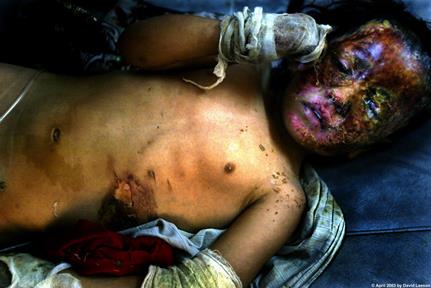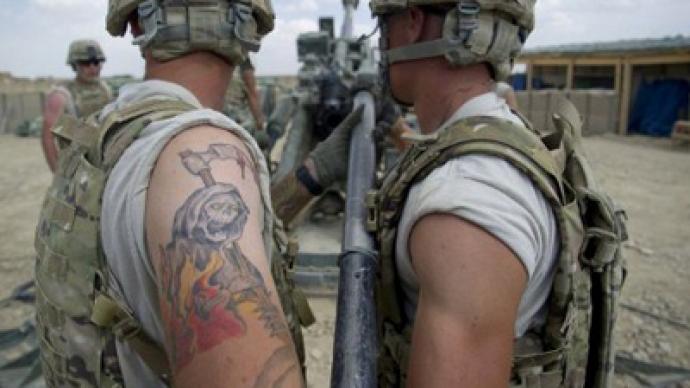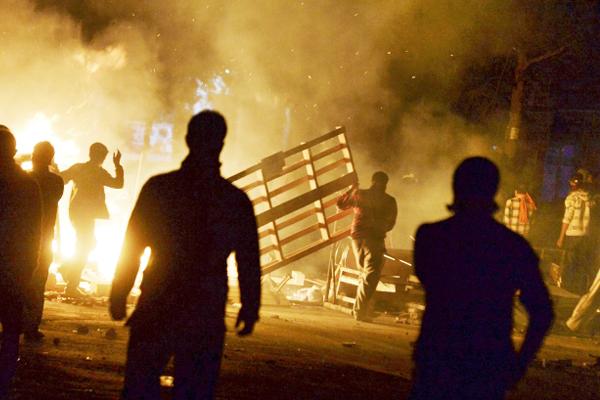Weapons of mass destruction: produced and used by the United States

by BRussells Tribunal on 17-09-2013
BRussells Tribunal
Chemical
weapons were used in Syria: by whom is not clear. In Iraq weapons of
mass destruction were used. By whom is very clear: the United States.

This Iraqi child is one of the millions of victims of the US Weapons of Mass Destruction
Already in 2005, The BRussells Tribunal published extensive reports on the use of white phosphorus in Iraq.
Do you want to study these reports again: click here
“American pilots dropped the controversial incendiary agent napalm on Iraqi troops during the advance on Baghdad. (…) ‘We napalmed both those [bridge] approaches,’ said Colonel James Alles, commander of Marine Air Group 11. ‘Unfortunately there were people there ... you could see them in the [cockpit] video. They were Iraqi soldiers. It's no great way to die. The generals love napalm. It has a big psychological effect.’" The Independent 10 August 2003
“One is sitting here in front of me on a stretcher, his face is very badly burned. Bits of skin are peeling off, other areas are simply weeping wounds, his hands are bandaged. The other man, his nephew, has lost all the skin off his back. It is a sickening sight. One of the men explains that the bombing from an American aircraft came without warning. There was no reason to attack their house. They had no weapons and were just relaxing at home. Speaking through a US marine interpreter the man said the US air strike killed 11 members of his family. Six were also badly burned as the phosphorus turned the inside of his home white hot.” BBC report 5 April 2003
Apparently for the US nothing is "outlawed". White Phosphorous, Daisy cutters, Depleted Uranium, Thermobaric bombs, Clusterbombs, Napalm, microwave weapons…. The US used Weapons of Mass Destruction against civilians.
And how many times will they have to adjust their official version?
The United Nations banned the use of napalm against civilians in 1980 after pictures of a naked wounded girl in Vietnam shocked the world.
The United States, which didn't endorse the convention, is the only nation in the world still using napalm.
Let's be very clear: White phosphorous, uranium weapons, napalm, cluster ammunition: they are all weapons of mass destruction, and only the US is using them, and according to numerous reports & witnesses, against Iraqi civilians.
A de-classified report from the US Department of Defense, dated April 1991 and titled “Possible use of phosphorus chemical” reads:
(…) IRAQ'S POSSIBLE EMPLOYMENT OF PHOSPHOROUS CHEMICAL WEAPONS -- IN LATE FEBRUARY 1991, FOLLOWING THE COALITION FORCES' OVERWHELMING VICTORY OVER IRAQ, KURDISH REBELS STEPPED UP THEIR STRUGGLE AGAINST IRAQI FORCES IN NORTHERN IRAQ. DURING THE BRUTAL CRACKDOWN THAT FOLLOWED THE KURDISH UPRISING, IRAQI FORCES LOYAL TO PRESIDENT SADDAM ((HUSSEIN)) MAY HAVE POSSIBLY USED WHITE PHOSPHOROUS (WP) CHEMICAL WEAPONS AGAINST KURDISH REBELS AND THE POPULACE IN ERBIL (…)
In other words, the Pentagon considers white phosphorous an illegal chemical weapon.
Do you want to study these reports again: click here
|
The BRussells Tribunal: essential in documenting the use of WMD and exposing the lies
* Dahr Jamail tells the real story: Fallujah Revisited (14 Nov 2005)
* Gabriele Zamparini: his
stories forced the US State Department and the BBC to correct their own
official statements & lies about the use of White Phosphorus ! (November 2005)
* Dirk Adriaensens: White Phosphorous, Daisy cutters, Depleted Uranium, Thermobaric bombs, Clusterbombs, Napalm…. The US uses WMD against civilians (11 Nov 2005) - Italian - German
* Medialens: The tragic blindness of the Embedded BBC- White Phosphorus, Fallujah And Unreported Atrocities (28 Nov 2005)
More Medialens Alerts: "NO GREAT WAY TO DIE” - BUT THE GENERALS LOVE NAPALM (30 March 2005) - And other highly revealing media alerts
* John Pilger: Mainstream journalism is the voice of rampant power (21 Nov 2005)
* Dr Geert Van Moorter in the RAI Video: Star Wars in Iraq , about lasers and microwave weapons (16 May 2006) - Read text file
|
|
RAI VIDEO | Fallujah: The Hidden Massacre (08 Nov 2005)
RAI VIDEO | Star wars in Iraq , about lasers and microwave weapons, with Dr. Geert Van Moorter (16 May 2006) - Read text file
|
|
Flashbacks: Fallujah: The Flame of Atrocity (website including pictures and movies of Fallujah) | Israel Used White Phosphorous (09 Nov 2005) | Incinerating Iraqis: The Napalm Cover-Up (07 July 2005) | Bush Officials Lied to Britain About US Use of Napalm in Iraq (17 June 2005) | PDF File: Fire bombs in Iraq: Napalm by any other name (17 Apr 2005) - Iraqanalysis.org | Napalm, Chemical Weapons Used at Fallujah – Iraqi Official (05 March 2005) | WMD Employed by US to Imolate Falluja: White Phosphorus is a Chemical Weapon (07 March 2005) | Odd Happenings in Fallujah (18 Jan 2005) - Dahr Jamail | Firebombing Falluja (01 Dec 2004) | Fallujah napalmed (29 Nov 2004) | U.S. uses napalm gas in Fallujah – Witnesses (28 Nov 2004) | Fallujah napalmed (28 Nov 2004) | 'Unusual Weapons' Used in Fallujah (26 Nov 2004) | US Troops Reportedly Gassing Fallujah (10 Nov 2004) | US admits it used napalm bombs in Iraq (10 Aug 2003) | Napalm use reported by CNN (March 2003) |
|
|
|
|
Answer of the US State department: Did the U.S. Use "Illegal" Weapons in Fallujah? . Excerpts: napalm
or napalm-like incendiary weapons are not outlawed. International law
permits their use against military forces, which is how they were used
in 2003. (...) Finally, some news accounts
have claimed that U.S. forces have used "outlawed" phosphorous shells
in Fallujah. Phosphorous shells are not outlawed. U.S. forces have used
them very sparingly in Fallujah, for illumination purposes. They were
fired into the air to illuminate enemy positions at night, not at enemy
fighters.
[November 10, 2005 note: We have learned that some of the information we were provided in the above paragraph is incorrect. White phosphorous shells, which produce smoke, were used in Fallujah not for illumination but for screening purposes, i.e., obscuring troop movements and, according to an article, "The Fight for Fallujah," in the March-April 2005 issue of Field Artillery magazine, "as a potent psychological weapon against the insurgents in trench lines and spider holes …." The article states that U.S. forces used white phosphorous rounds to flush out enemy fighters so that they could then be killed with high explosive rounds.] There is a great deal of misinformation feeding on itself about U.S. forces allegedly using "outlawed" weapons in Fallujah. The facts are that U.S. forces are not using any illegal weapons in Fallujah or anywhere else in Iraq. |
“American pilots dropped the controversial incendiary agent napalm on Iraqi troops during the advance on Baghdad. (…) ‘We napalmed both those [bridge] approaches,’ said Colonel James Alles, commander of Marine Air Group 11. ‘Unfortunately there were people there ... you could see them in the [cockpit] video. They were Iraqi soldiers. It's no great way to die. The generals love napalm. It has a big psychological effect.’" The Independent 10 August 2003
“One is sitting here in front of me on a stretcher, his face is very badly burned. Bits of skin are peeling off, other areas are simply weeping wounds, his hands are bandaged. The other man, his nephew, has lost all the skin off his back. It is a sickening sight. One of the men explains that the bombing from an American aircraft came without warning. There was no reason to attack their house. They had no weapons and were just relaxing at home. Speaking through a US marine interpreter the man said the US air strike killed 11 members of his family. Six were also badly burned as the phosphorus turned the inside of his home white hot.” BBC report 5 April 2003
Apparently for the US nothing is "outlawed". White Phosphorous, Daisy cutters, Depleted Uranium, Thermobaric bombs, Clusterbombs, Napalm, microwave weapons…. The US used Weapons of Mass Destruction against civilians.
And how many times will they have to adjust their official version?
The United Nations banned the use of napalm against civilians in 1980 after pictures of a naked wounded girl in Vietnam shocked the world.
The United States, which didn't endorse the convention, is the only nation in the world still using napalm.
Let's be very clear: White phosphorous, uranium weapons, napalm, cluster ammunition: they are all weapons of mass destruction, and only the US is using them, and according to numerous reports & witnesses, against Iraqi civilians.
A de-classified report from the US Department of Defense, dated April 1991 and titled “Possible use of phosphorus chemical” reads:
(…) IRAQ'S POSSIBLE EMPLOYMENT OF PHOSPHOROUS CHEMICAL WEAPONS -- IN LATE FEBRUARY 1991, FOLLOWING THE COALITION FORCES' OVERWHELMING VICTORY OVER IRAQ, KURDISH REBELS STEPPED UP THEIR STRUGGLE AGAINST IRAQI FORCES IN NORTHERN IRAQ. DURING THE BRUTAL CRACKDOWN THAT FOLLOWED THE KURDISH UPRISING, IRAQI FORCES LOYAL TO PRESIDENT SADDAM ((HUSSEIN)) MAY HAVE POSSIBLY USED WHITE PHOSPHOROUS (WP) CHEMICAL WEAPONS AGAINST KURDISH REBELS AND THE POPULACE IN ERBIL (…)
In other words, the Pentagon considers white phosphorous an illegal chemical weapon.








